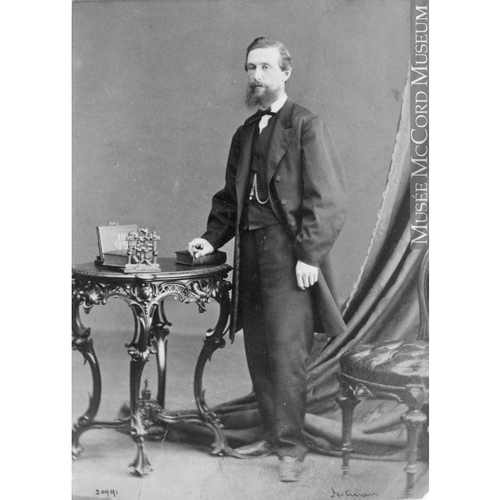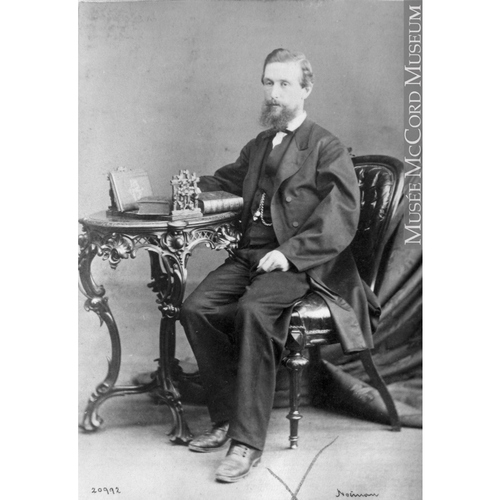CASSILS, WILLIAM, telegraph operator and businessman; b. 25 June 1832 in Denny, Scotland, eldest son of John Cassils and Margaret Murray; m. 11 June 1856 Agnes Simpson Hossack at Quebec; they had no children; d. 25 Dec. 1891 in Montreal.
William Cassils grew up in the village of Renton, Scotland, and was educated at the local school. Encouraged by relatives settled in the Canadas, he immigrated in the spring of 1851 and soon became an apprentice telegraph operator in Montreal for the Montreal Telegraph Company. Under Hugh Allan* from 1852, it expanded quickly, absorbing most of its competitors. Cassils advanced rapidly and soon was supervising the installation of a line following the Grand Trunk Railway; in November 1853 he was promoted manager of the firm’s Quebec office. From that year the Montreal Telegraph Company competed with Quebec’s British North American Electric Telegraph Association for the Montreal–Quebec market. The profits made by the Montreal firm on its other lines enabled it to prevail and, after the absorption of its Quebec rival in 1856, Cassils served as the superintendent of Montreal Telegraph’s eastern division. By 1865 the company had acquired all lines on New Brunswick’s north shore and had constructed a line to Saint John and Halifax.
Cassils left Montreal Telegraph’s Quebec office in November 1866 and returned to Montreal where, the following year, he entered into partnership with George A. Cameron; the firm of Cassils and Cameron opened a hoop-skirt factory but, quickly adding imports, evolved into a wholesale business for fancy dry goods. In 1876, however, Cassils left Cameron to organize the Canadian District Telegraph Company, of which he became president; the vice-president was Conservative senator Matthew Henry Cochrane*, the father-in-law and business associate of Cassils’s brother Charles. By 1881 the company had become associated with Allan’s Montreal Telegraph Company. Allan became president and William Cassils dropped to vice-president. Cassils regained the presidency in 1882, but his firm remained closely tied to Montreal Telegraph; indeed the relationship was reinforced in 1883 by Cassils’s appointment to the latter’s board of directors.
In the 1880s Cassils tied his star firmly to the developing sectors of transportation and communications, and as a consequence his business interests became increasingly intertwined with those of the rapidly expanding Canadian Pacific Railway. About 1877 Cassils had become president of the Canada Central Railway Company, which in 1881 merged with the CPR. He then served as receiver of the financially floundering St Lawrence and Ottawa Railway Company, whose line was leased to the CPR in 1884. The following year, as president of the Dominion Transport Company, he obtained the contract for the CPR’s cartage trade in Toronto.
The same year Cassils acted as negotiator for the CPR in discussions with the Western Union Telegraph Company, the object of which was to obtain a majority interest for the CPR in the Great North Western Telegraph Company of Canada. The CPR considered the telegraph vital for its own operations, but it was interested as well in expanding its activities into a service closely related to transportation. The Canadian telegraph system was dominated by the Montreal Telegraph Company and the Dominion Telegraph Company. In 1881 these firms had put an end to competition between themselves by leasing their lines to the Great North Western Telegraph Company, which was owned by Western Union, an American firm. By acquiring a majority interest in Great North Western the CPR would gain domination of the service in Canada. A tentative agreement drafted by Cassils was signed by Norvin Green, president of Western Union, and William Cornelius Van Horne*, general manager of the CPR, but the deal collapsed over the price of the stock and assumption by the CPR of rental guarantees for the leased lines. Cassils thus lost his chance to become president of Great North Western. He maintained his penchant for the communications business, nevertheless; in 1889 he became president of the Federal Telephone Company. He was also president of the Electro-Mechanical Clock Company, vice-president of the British American Ranch Company, and director of the Montreal Herald, the Windsor Hotel Company of Montreal, and several financial institutions.
Like many businessmen of his standing, Cassils was involved in the management of educational, religious, and social institutions. While at Quebec he had been secretary-treasurer of the Quebec Protestant School Board. In Montreal he served on the board of managers of Erskine Presbyterian Church from 1868 to 1871. He and his wife abruptly left the church in October 1872, probably as a result of controversy over the introduction of instrumental music during services that eventually split the congregation; they joined the American Presbyterian Church, which utilized organ music. There Cassils was less active; in 1874 he was nominated but not elected to the position of elder. Gregarious and an able raconteur, he frequented Montreal social gatherings. He was particularly remembered by the St Andrew’s Society for his enthusiastic participation in annual celebrations. “Possessed [of] a fine tenor voice . . . ,” according to one contemporary, “he rendered the songs of his native land with a sweetness and pathos few could equal.” He was also a member of such social groups as the St James Club and the Fish and Game Club, of which he was president.
About October 1891 Cassils fell ill with a heart malady, and on Christmas Day he died – fittingly, at the Windsor Hotel. His business accomplishments had been based on timely diversification into various transportation and communications ventures but, although generally successful in business and a close collaborator of tycoons such as Allan and Van Horne, he was never their equal.
ANQ-M, CE1-130, 28 déc. 1891; CM 1, testaments homologués, 4 févr. 1893. ANQ-Q, CE1-67, 11 juin 1856. Canadian Pacific Arch. (Montreal), Van Horne corr, incoming corr, nos.13029, 14431; letter-book no.12, 15 Aug. 1885. St Andrew’s Soc. Arch. (Montreal), Annual reports, 1870–89; “List of St Andrew’s Society Presidents, 1835–1988”; Minute-book, 1835–84. UCC, Montreal-Ottawa Conference Arch. (Lennoxville, Que.), A/2, A/30, E/3, E/21, E/88, E/210/1. Gazette (Montreal), 26 Dec. 1891. Monetary Times, 1 Jan., 6, 27 May, 5 Aug. 1892. Montreal Daily Star, 26 Dec. 1891. Cyclopædia of Canadian biog. (Rose and Charlesworth). C. P. Dwight, “History of Canadian telegraphy,” Canada, an encyclopædia (Hopkins), 6: 530–35. Montreal directory, 1867–91. [Robert Campbell et al.], A summary of the first fifty years transactions of the St Andrew’s Society of Montreal (Montreal, 1886). D. C. Knowles, “The American Presbyterian Church of Montreal, 1822–1866”
Cite This Article
Gordon Burr, “CASSILS, WILLIAM,” in Dictionary of Canadian Biography, vol. 12, University of Toronto/Université Laval, 2003–, accessed April 24, 2025, https://www.biographi.ca/en/bio/cassils_william_12E.html.
The citation above shows the format for footnotes and endnotes according to the Chicago manual of style (16th edition). Information to be used in other citation formats:
| Permalink: | https://www.biographi.ca/en/bio/cassils_william_12E.html |
| Author of Article: | Gordon Burr |
| Title of Article: | CASSILS, WILLIAM |
| Publication Name: | Dictionary of Canadian Biography, vol. 12 |
| Publisher: | University of Toronto/Université Laval |
| Year of revision: | 1990 |
| Access Date: | April 24, 2025 |




